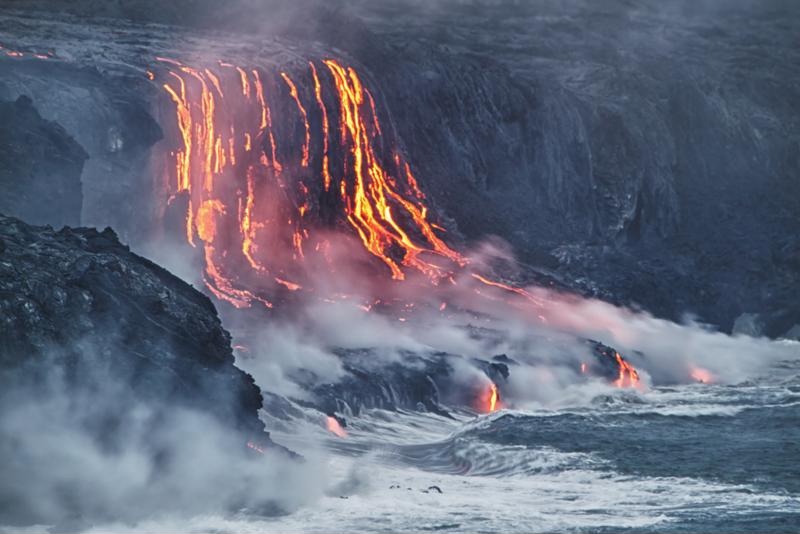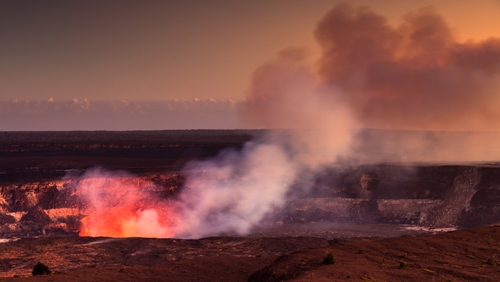If it’s you and your traveling party’s first time visiting the Big Island of Hawaii, it’s practically mandatory that you all experience the natural wonders of Hawaiʻi Volcanoes National Park. This outdoor attraction is home to two of the most active volcanoes in the world, and is perfect for any vacationers looking for an active, exotic adventure. Before you get settled into your Hawaii vacation rental, you’ll need to start planning out your day at this famous UNESCO World Heritage Site to make sure you get to see and experience everything there is to offer. Here are just a few of the incredible memories you can create during a day spent at Hawaiʻi Volcanoes National Park:
Tour Kilauea
A trip to Hawai’i Volcanoes National Park will allow you to see a massive active volcano that can produce anywhere between 250,000 to 650,000 cubic yards of lava per day. Kilauea is the most active volcano you can find on any of the Hawaiian islands, and reaches a peak height of just over 4,000 feet. It’s also commonly referred to as “the world’s only drive-in volcano,” as visitors have access to more than 20 miles of road with ample opportunities to see the active lava flowing by. If you have a rental car you can cruise along the Crater Rim Drive Tour, an incredibly scenic drive within the park that can lead to encounters with lava and local wildlife. On this drive, you’ll come across the Chain of Craters Road, which eventually arrives at a halt due to actual lava overflowing across the street. Those who are curious to know more about the history of Kilauea should stop at the Kilauea Visitor Center, where you can watch an educational film or ask park rangers questions.
 The only spot on the Big Island where you’ll be able to see lava flow directly into the ocean.
The only spot on the Big Island where you’ll be able to see lava flow directly into the ocean.Take a hike
If you’re ever feeling too cooped up in your Hawaii condo rental, you’ll have plenty of opportunities to get active on the abundance of trails found at Hawai’i Volcanoes National Park. Here you’ll find more than 150 miles of walking paths and hiking trails that range in difficulty, so you’ll be sure to embark on one that’s accommodating for all members of your vacationing group. Those looking for a trail that’s a little easier than the rest should take a hike out on the Kīpukapuaulu (Bird Park) or Nāhuku (Thurston Lava Tube) routes. Both of these paths offer great chances to take in the beautiful surroundings while not working up a big sweat. Anyone who’s in need of a more challenging path should take the hike along the Chain of Craters Road or Kilauea Summit trails, but be prepared to endure at least a few hours of exploration.
“Experience what it’s like to walk through a 500-year-old lava cave.”
Go tubing
As previously stated, the Thurston Lava Tube is an extremely accommodating walking route for all travelers. Of course, it might be the most memorable hiking trail as well, considering that visitors who take on this path will eventually be walking through a 500-year-old lava cave. After thousands of years of lava melting together, this naturally formed cave was created. Park rangers have installed various lights, handrails and walkways so you can experience what’s most likely the closest you’ll ever be to exploring inside a volcano. Tour guides can lead you through darker and more intimate tunnels where flashlights will reveal incredible rock formations and colors caused by the mixtures of various minerals. Once you’ve reached the end of the route, you’ll enter into a beautiful tropical rainforest, providing quite the contrast from the dark and mysterious interior of the Thurston Lava Tube.
Learn the history
While wandering around and exploring all the terrain will certainly take up a bit of time, you should also enlighten yourself with some history of the park. If you’re planning on stopping by the Halemaumau Crater, make sure you snap a few pictures of the historic Volcano House, which has been a famous vacation destination for icons such as Mark Twain. Halemaumau Crater is also an important historic site, as this was where the original inhabitants of the land paid tribute to the volcano goddess Pele. The Thomas A. Jaggar Museum is another great attraction where you can learn more about the evolution of volcanoes on Hawaii. Here visitors can get involved with several interactive displays, maps and videos that better explain how the park has formed over hundreds of thousands of years, and learn more about what actually causes a volcano to erupt.

